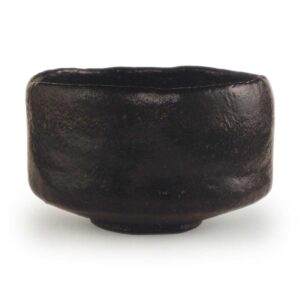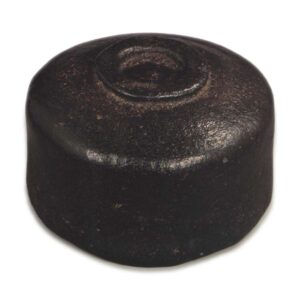

Height: 7.3-7.5cm
Diameter: 12.0cm
Foot diameter: 5.7cm
Height: 0.8-0.9cm
It seems that the fact that there are two Ichimonji-mei Chojiro tea bowls, one red and one black, has been known among tea masters since ancient times, and there are also descriptions of them in old tea books. According to the “Famous Tea Bowl Collection”,
there are two Ichimonji bowls, one red and one black
one Ichimonji Chojiro red, inscribed with the name of Rikyu, with the Rikyu seal, from the Kuwana Kagiya store, and one Ichimonji Chojiro black, inscribed with the name of Soshitsu, with the Rikyu seal, owned by Uraku, and passed down through the Ishikawa Shosai family, and one Ichimonji Chojiro black, inscribed with the name of Rikyu, owned by the Kyoto Okada family, and passed down through the Nakasuke family.
Ichimonji Chojiro Kuro, Sositsu Me, Rikyu Ichimonji, Uraku Possession, Ishikawa Shosai, Kyō Okada Nakasuke
It is clear that this tea bowl corresponds to the black tea bowl, but the name of the person Ishikawa Shosai is not mentioned in the accompanying letter of provenance. Alternatively, it may have been in the possession of Ishikawa Shosai after the accompanying letter from Inukai.
The tea bowl has the same monogram, but the red and black versions are quite different in terms of their production, and this black tea bowl has a monogram that is similar to that of the “Shunkansai” tea bowl. However, the glaze is not as smooth as that of the Shunkansai.
It is a shallow bowl with a slight waist, and the mouth is loosely turned inwards.
The inside of the bowl is quite wide, and a shallow tea pool can be seen in the center.
The foot ring is also slightly low, and the tatami mat is wide, with the inside of the foot ring gently flowing. Furthermore, the area around the foot ring is also slightly raised, similar to Shunkans, and it is thought that the same potter probably made both Shunkans and Chojiro ware. There are five marks left on the inside of the bowl.
On a piece of paper attached to the inside of the lid of the box, there is a note written by Kosomuro, or Senso, which says
There are two letters written by Rikyu, one of which is a black tea bowl by Chojiro, owned by Takayama Nanbo, and later by Oda Uraku. Kosomuro (signature)
It is known that Rikyu named it Ichimonji and wrote the character “一” in red directly on the inside of the bowl. The character “一” in red that can be seen on the inside of the bowl now is thought to have been added later, as Rikyu’s original writing had worn away.
Furthermore, there is a letter from Senso attached, and the text of the letter is as follows: “Rikyu Ichimonji Meibutsu Kuro Chawan Rei Ichiran, Nani Shigeru Masaharu, Kotate Kari Osashimasho, Gohizouka Kasei Naru, Shoumen Kasan Deshitsuru, Koukou Kanshin, Nanatsu Yobi, Sou (kao), Ikai Tazaemon-dono, Sou Shitsu”. In other words, it was probably presented to the list by Inukai Tazaemon, and then the certificate of authenticity was sent on the back of the inner box lid.
The history of the tea bowl is detailed in another accompanying letter, which says: “Rikyu’s signature is written in black on the inside of the black and red tea bowl, and in red on the inside of the black tea bowl. The black tea bowl was passed down from Rikyu to Takayama Nanbo, then to Oda Urakusai, and then to the Ikai family. It was then passed down to the Inukai family, and then to Norisen-so Gokujaku, and then to Okada Masaari, and then to the Honke family in Shimbehon in the tenth month of the year of the cock in the second year of the Kyoho era, and then in the third year of the Kyoho era in the twelfth month, it was passed down from the right-hand chief retainer Shimizu Genbei, and then it was passed down over the years, and then it was passed down to the Urasenke family from the Zen priest of the Oubai-in temple of the Daitokuji temple, and then it was appraised and a letter of authentication was added. The Urasenke Soshitsu at the end of the text refers to Gengensai.
The bag is a white crepe bag with a crumpled texture, and the paulownia inner box is lacquered with a maki-e design of a cock’s comb on the front of the lid. The outer box is black with a maki-e polka dot design. It is probably something that would have been to Gengensai’s taste. The accompanying letter from Senso is written on a scroll, but the calligraphy on the box is by Iki Sansaisai.



